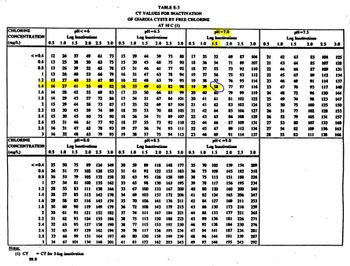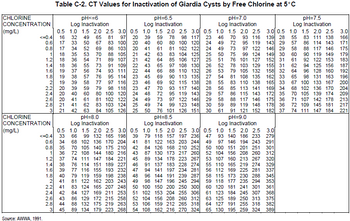
Concept explainers
A drinking water treatment plant with conventional treatment uses on disinfection segment consisting of a rectangular basin, with a theoretical detention of 270 min with a baffling factor of 0.5. The average free chlorine residual recorded at the disinfection segment monitoring location in 1.6 mg/L. The lowest free chlorine residual recorded was 1.2 mg/L during peak flow. The water temperature is 5C and pH is 7.5
a) Determine the inactivation ratio if 0.5-log inactivation of Giardia lamblia cysts is required
b) Under these design conditions, have Giardia lamblia cysts been adequently inactivated?
c) Will the plant achieve adequete Giardia lamblia inactivation if 0.5-log inactivation is required but the water temperature is raised to 10C?
d) Will the plant achieve adequete Giardia lamblia inactivation if 3-log inactivation is required and the water temperature remain at 5C?
e) Will the plant achieve adequete Giardia lamblia inactivation if 3-log inactivation is required and the water temperature is raised to 10C


Step by stepSolved in 6 steps with 4 images

- Two circular clarifiers operated in parallel service a single stage bio-tower system (plastic media) that receives municipal wastewater at an average flow (Qaverage) of 2000 m³/d, with BOD5 = 200 mg/L. The internal flow recirculation ratio is 2.4. The maximum overflow rate for the clarifiers is 1.8 m³/m²-hr. The design procedures require that the sizing of the clarifiers be based on "PEAK" flow which is twice the average flow (Qpeak = 2 × Qaverage), and media depth in the biotower is 3.0 m. Determine: (a) The overall BOD5 removal. (b) the surface area and the diameter of each clarifier. (k = 0.06 min¹; n = 0.5),arrow_forward2,13. Determine the suspcnded solids and the percent volatule matter in a sohds sample based on the following data: Sample size - 25 mL. Tare mass of filter 1.5325g Tare mass of filter plus retained solids-1.5415 g. Tare mass of filter plus retained ash-1.5378garrow_forwardIn a BOD test, 5 ml of wastewater (with no dissolved oxygen) is diluted with 295 ml of water containing 8.5 mg/1 of dissolved oxygen. After 5 days incubation at 25°C, the dissolved oxygen content of the mixture is 5 mg/1. Temperature coefficient can be taken as 1.047 and BOD rate constant is 0.23 per day (base e) at 20°C. The ultimate biochemical oxygen demand of the wastewater isarrow_forward
- Liquid alum is delivered to a water treatment plant which contains 642.3 milligrams of alum per milliliter of liquid solution. Jar tests indicate that the best alum dose is 8 mg/L. Determine the setting on the liquid alum chemical feeder in milliliters per minute when the flow is 2.2 MGD.arrow_forwardHomework - A sample of wastewater was incubated for 7-days at 20°C and showed a BOD of 208 mg/L.. Assuming k=0.15 day', calculate: (i) Its 5-days BOD( ii) Its 10-days BOD (iii) Its ultimate BODarrow_forward

 Structural Analysis (10th Edition)Civil EngineeringISBN:9780134610672Author:Russell C. HibbelerPublisher:PEARSON
Structural Analysis (10th Edition)Civil EngineeringISBN:9780134610672Author:Russell C. HibbelerPublisher:PEARSON Principles of Foundation Engineering (MindTap Cou...Civil EngineeringISBN:9781337705028Author:Braja M. Das, Nagaratnam SivakuganPublisher:Cengage Learning
Principles of Foundation Engineering (MindTap Cou...Civil EngineeringISBN:9781337705028Author:Braja M. Das, Nagaratnam SivakuganPublisher:Cengage Learning Fundamentals of Structural AnalysisCivil EngineeringISBN:9780073398006Author:Kenneth M. Leet Emeritus, Chia-Ming Uang, Joel LanningPublisher:McGraw-Hill Education
Fundamentals of Structural AnalysisCivil EngineeringISBN:9780073398006Author:Kenneth M. Leet Emeritus, Chia-Ming Uang, Joel LanningPublisher:McGraw-Hill Education
 Traffic and Highway EngineeringCivil EngineeringISBN:9781305156241Author:Garber, Nicholas J.Publisher:Cengage Learning
Traffic and Highway EngineeringCivil EngineeringISBN:9781305156241Author:Garber, Nicholas J.Publisher:Cengage Learning





